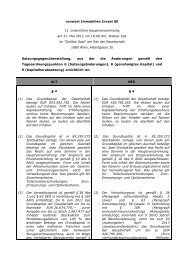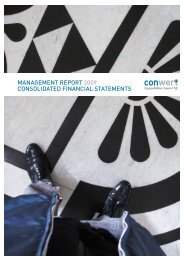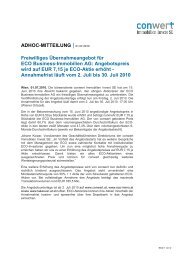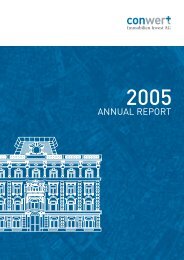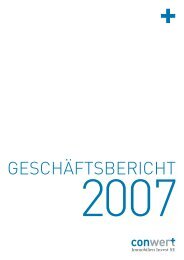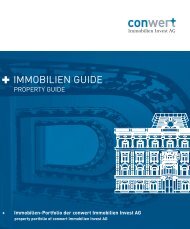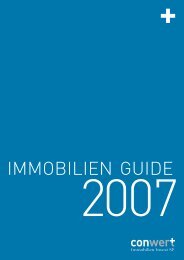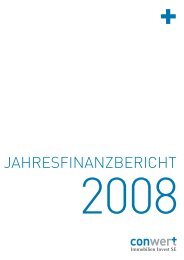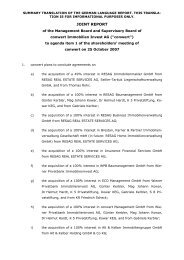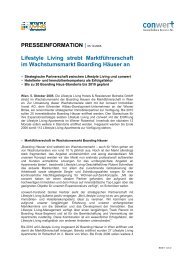annual financial statement 2011 - conwert Immobilien Invest SE
annual financial statement 2011 - conwert Immobilien Invest SE
annual financial statement 2011 - conwert Immobilien Invest SE
Create successful ePaper yourself
Turn your PDF publications into a flip-book with our unique Google optimized e-Paper software.
CONWERT IMMOBILIEN INVEST <strong>SE</strong><br />
ANNUAL FINANCIAL <strong>2011</strong> STATEMENT ANNUAL REPORT <strong>2011</strong><br />
62<br />
DERECOGNITION OF FINANCIAL AS<strong>SE</strong>TS<br />
An asset is derecognised when the contractual rights to the cash flows arising from the asset<br />
expire. An asset is also derecognised when all major risks and rewards associated with the asset<br />
are transferred.<br />
IMPAIRMENT OF FINANCIAL AS<strong>SE</strong>TS<br />
As of every balance sheet date, the <strong>conwert</strong> Group tests its <strong>financial</strong> assets or groups of assets to<br />
identify any objective evidence of impairment. A <strong>financial</strong> asset or group of <strong>financial</strong> assets is only<br />
considered to be impaired when one or more events have occurred since the initial recognition<br />
of the asset (a “loss event“) and this loss event has an impact on the estimated future cash flows<br />
of the <strong>financial</strong> asset or group of <strong>financial</strong> assets that can be reliably estimated. Evidence of impairment<br />
includes the following: signs that a debtor or group of debtors has significant <strong>financial</strong><br />
difficulties; default or delinquency in interest or principal payments; the probability of bankruptcy<br />
or other <strong>financial</strong> reorganisation; and when observable data indicates there will be a measurable<br />
decrease in estimated future cash flows, e.g. due to an increase in delayed payments or economic<br />
conditions that correlate with default.<br />
An impairment charge is recognised to receivables through a valuation adjustment account when<br />
there are substantial objective indications that the Group will not be able to realise the full amount<br />
of the receivables. The impairment charge is calculated as the difference between the carrying<br />
amount and the present value of expected future cash flows. Material <strong>financial</strong> assets are tested<br />
individually for impairment, while <strong>financial</strong> assets that are not considered to be material are tested<br />
individually or together. If the <strong>conwert</strong> Group determines that there are no indications of impairment<br />
to an individually tested <strong>financial</strong> asset – whether the asset is considered material or not –<br />
the asset is aggregated together with other <strong>financial</strong> assets that have similar credit risk profiles,<br />
and the group of assets is subsequently tested for impairment. In cases where the impairment<br />
tests of individual assets led to the recognition of an impairment charge, these assets are not<br />
included in any further aggregated testing.<br />
If the estimated impairment increases or decreases in a later accounting period due to another<br />
event, the previously recognised impairment charge is increased or decreased through the valuation<br />
adjustment account with a corresponding recognition to profit or loss.<br />
Receivables are derecognised when they are classified as uncollectible. If a derecognised receivable<br />
is subsequently reclassified as collectible because of an event that occurred after derecognition,<br />
the relevant amount is immediately recognised to profit or loss.<br />
The <strong>conwert</strong> Group also tests available-for-sale <strong>financial</strong> assets for objective signs of impairment<br />
as of every balance sheet date. For available-for-sale equity instruments, a significant or lasting<br />
decline in the fair value of the instrument below its acquisition cost would represent an objective<br />
indication of impairment. If there are any indications of impairment, an impairment charge is recognised<br />
to profit or loss at an amount equal to the difference between the acquisition cost and the<br />
current fair value.<br />
Debt instruments are considered to be impaired when the expected future cash flows are likely to<br />
be cancelled or delayed. If debt instruments classified as available for sale are considered to be<br />
impaired, interest is still recorded on the reduced carrying amount of the relevant asset based on<br />
the original effective interest rate; this interest is included under finance revenue.<br />
The reversal of impairment charges to equity instruments takes place through equity, and for debt<br />
instruments through profit or loss.



